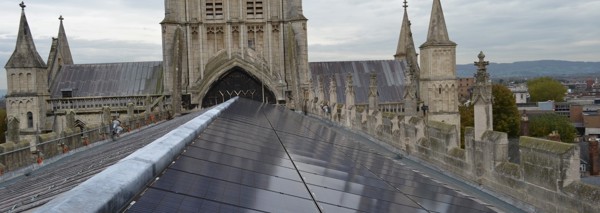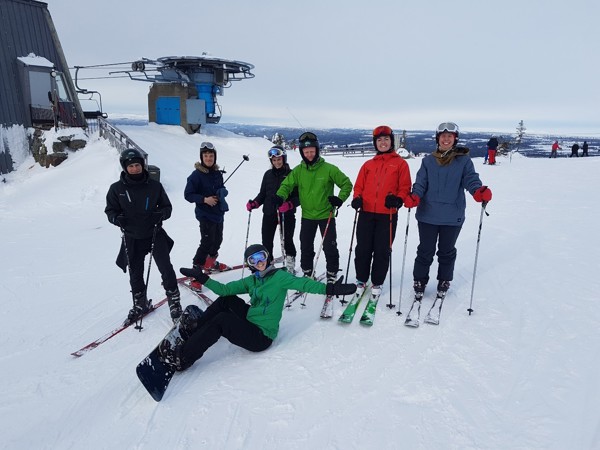- Magazine
- Trainee Blog
- Maintenance – A world of continuous improvement
Maintenance – A world of continuous improvement
Robots are amazing creatures. These beautiful beings with long gracious arms, brains made from copper wire and circuit boards, and hearts of cold hard steel. There are few things as mesmerizing as watching a robot buzz around as it carefully but determined picks up and places hundreds of pieces of silicon.
The hydraulic fluid pumps rapidly in the robot’s veins as it endlessly strives to fulfill its owner’s commands of seemingly meaningless series of movements. It almost becomes a dance as it gently interacts both with other machines and with people, performing the same task over and over…
## SOUND OF SCREECH FROM A STOPPING RECORD PLAYER ##
That is, of course, until it breaks down, and starts crying for the help of the maintenance department.
Maintenance is an important part of any industrial plant, and for my first trainee period I have been working with maintenance management at REC Solar Norway (until March 2018 known as Elkem Solar, and referred to only as Solar for the rest of this blog post) in Kristiansand. A maintenance team in a modern process plant typically consists of industrial mechanics, electricians, IT-specialists, and more. The team’s role is to keep all the equipment in order, make repairs in the event of breakdowns, and in some cases, make improvements and modifications. Because the challenges of the maintenance team can be complex and intertwined, managing the team in an efficient way is important to achieve high performance. As my background from Mechatronics includes topics from both mechanical engineering, electrical engineering, control systems and computer science, working with maintenance management was a fitting task for my first trainee period.
REC Solar is a solar module manufacturer that includes the whole value chain from raw materials (mainly quartz and coal) to completed market-ready solar modules. They have plants in Kristiansand and Porsgrunn in Norway, and in Singapore. At the plant in Kristiansand, the silicon is processed through five steps, where the first one is the typical furnace process. The silicon is then crushed and treated in several ways until the output of 99.99999 % pure solar grade silicon is obtained. The modules themselves are produced and assembled in Singapore.

Picture: The illustration shows the process steps at the plant in Kristiansand.

Picture: The illustration shows the process all the way to completed solar modules.
Installments of panels containing silicon processed in Kristiansand can be found all over the world. From factory buildings of companies such as Asko (Lillesand, Norway) and Tesla (USA), to more special installations such as the Gloucester cathedral in the UK (where three of the Harry Potter movies were filmed).

Picture: Gloucester cathedral, UK, with REC BLK2 solar modules. Photo: Mypower UK.
For the past 15 months I have been working with maintenance in the Post Treatment department of Solar’s Kristiansand plant (I was given the opportunity to get a “head start”, and started working here already in January last year). I’ve acted as the maintenance manager, and my role has included representing the maintenance department in projects/project meetings, working with cost and efficiency improvements, and doing the daily follow-up of the personnel. I didn’t really have any experience with maintenance, and as my background was not very practical, the learning curve was very steep in the beginning. I quickly learned that a lot of the things you can “assume” or “neglect” in theoretical problems and models have a huge impact on real equipment. Elements such as friction, wear and tear, deformation, environmental conditions (temperature etc.), and the general mood of the people at work all have an effect how well the machines are performing. If everything had worked as they theoretically “should”, there wouldn’t have been a need for maintenance at all.
The performance of maintenance is often measured by “technical availability” of the equipment. This means the percentage of time when the machine is available for normal production. Stops for repairs caused by breakdowns, or planned stops such as weekly preventive maintenance or modification of equipment, then subtracts from the overall technical availability. Improving this by reducing the down-time has been one of the most important projects for me during the trainee period. By analyzing the down-time of the production, I was, in cooperation with everyone from operators and mechanics to process engineers and managers, able to identify specific actions that could improve the technical availability. This included looking into common alarms in the system, and creating improved trending of the causes for halted production. This method of working comes directly from the core of EBS (Elkem Business System), and the “continuous improvement”-mentality found in all Elkem’s plants. Small things, such as speeding up a robot’s movement for parts of the process, replacing a component with one of better quality, or making a minor design change to a machine, will not by themselves give a significant change in the overall performance of the plant. However, when these actions happen one by one, for month after month, then over time the result is a significantly improved situation. During this trainee period I’ve then gotten first-hand experience of the superpowers of the maintenance department.
Because any good trainee blog post includes something about life as a trainee outside of work, I will add a paragraph about that too. During my first trainee period, Kristiansand has seemed to be the hub for both current and former trainees. For a lot of the time, we have been four trainees located here at the same time (out of a total of nine). In addition, there are many former trainees who now hold permanent positions in Kristiansand. This group of people has often been meeting up for quizzes and other social activities. While in Solar, I have also met a lot of nice people through the company football team, who have weekly trainings and matches throughout the year. Finally, the yearly trainee trip to Hafjell was also arranged during the first weekend of March. As usual, (most of) the trainees met up for a weekend of socializing, skiing, after-skiing, and sauna-ing. Everyone made it home alive, even though a couple of us were a little bit skeptical about the skiing part (myself especially, as it was only my third time ever to go alpine skiing!).

Picture: In the picture (from the left): Adam, Otto, Andrea, Åsmund, Marthe and Sofie. In front: former trainee Marie. Not in the photo: Anne-Laure, Svein (photographer).
I’m writing this blog post in the last days of my trainee period in Solar, and it’s strange to think that after the Easter holidays I will not go back. In the 15 months spent at Solar I have learned so much, both about how to keep a process plant running, and about how life works outside of the lecture hall. I’ve met a lot of nice people, and gotten a really good understanding of why “continuous improvement” is one of the main values in all of Elkem. My next trainee period will be at Elkem Carbon Global, which is also based in Kristiansand. I look forward to getting started in my new role within digitalization and automation, but I think that I will have to “crash” Solar’s Friday waffles from time to time in order to keep in touch.